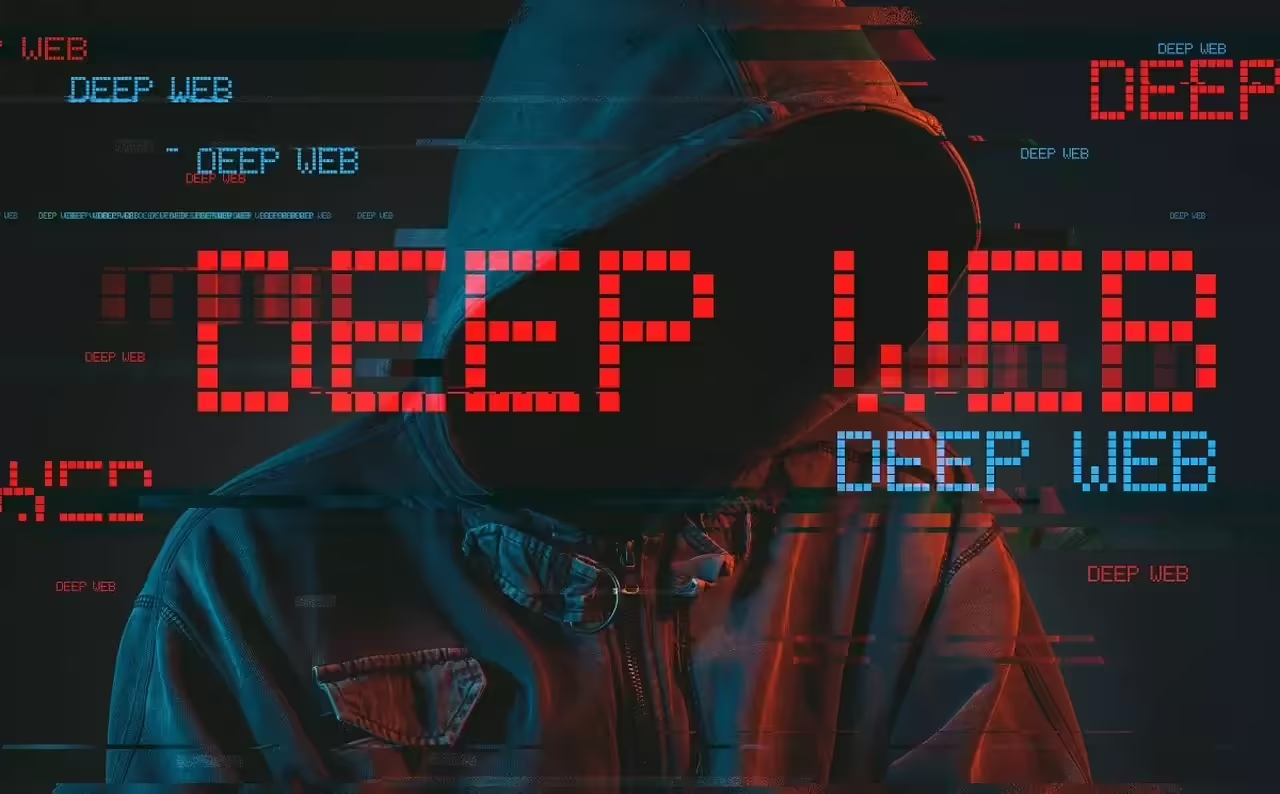
In the digital era we live in, the Internet has become a vast ocean of information, accessible with just a few clicks. However, what most users experience is only the tip of the iceberg, known as the “Surface Web”. Beneath this visible surface lies a darker and more mysterious world called the “Deep Web”.
What is the Deep Web? The Deep Web, also known as the “invisible web” or “dark web”, refers to all online content that is not indexed by conventional search engines like Google, Bing, or Yahoo. This includes databases, password-protected websites, restricted files, encrypted communications, and much more. In simple terms, the Deep Web is everything you can’t find using a standard search engine.
Differences between the Deep Web and the Surface Web The main difference between the Deep Web and the Surface Web lies in their accessibility and visibility to the general public. While the Surface Web is easily accessible and navigable through search engines, the Deep Web requires specific tools and knowledge to access it. Here are some key distinctions:
Unindexed Content: The Deep Web hosts a wealth of content that is not indexed by conventional search engines. This includes database files, medical records, password-protected academic content, and more.
Anonymity and Privacy: Many users turn to the Deep Web to protect their anonymity and privacy. Communications on the Deep Web are often encrypted, and users can access websites anonymously using tools like Tor (The Onion Router).
Illicit Activities: While the Deep Web is not inherently illegal, its anonymity and lack of oversight have made it a haven for illicit activities such as the black market for drugs, illegal pornography, the sale of stolen information, and other cybercrimes.
Myths and Realities The Deep Web has been the subject of numerous myths and misconceptions, fueled in part by its portrayal in the media and popular culture. Here are some important clarifications:
All Content is Illicit: While the Deep Web certainly hosts illegal activities, it also contains a wealth of legitimate and legal information, such as academic resources, digital libraries, and discussion forums on a variety of topics.
It is Inaccessible: Although the Deep Web requires a different level of access compared to the Surface Web, it is not inaccessible to the average user. Tools like Tor Browser allow users to explore the Deep Web relatively easily.
It is Dangerous to Navigate: While there are risks associated with navigating the Deep Web, such as encountering disturbing content or being exposed to illegal activities, navigating cautiously and avoiding suspicious sites can significantly reduce these risks.
Unraveling the Differences: Deep Web vs. Dark Web
In the vast universe of the Internet, there are two terms that are often intertwined and confused: the Deep Web and the Dark Web. Although both are beyond the reach of conventional online search, they are distinct entities with unique characteristics and purposes.
Deep Web: The Unexplored Repository
The Deep Web, often referred to as the “invisible web”, constitutes the portion of the Internet that is not indexed by conventional search engines. This vast digital territory includes dynamically protected content, restricted databases, company files, and communications encrypted and unlinked from other web pages. In essence, the Deep Web is everything that does not appear in Google, Bing, or similar search engine results.
The Deep Web is not necessarily a dark or dangerous place; in fact, much of its content is entirely legal and useful. Scientific research files, medical records, corporate intranets, and digital libraries are just some examples of what can be found in this vast digital repository. However, due to its unindexed nature, browsing the Deep Web requires direct access or specific tools, limiting its accessibility to common Internet users.
Dark Web: The Digital Underworld
In contrast, the Dark Web, also known as the “dark web”, is an even more clandestine and closed part of the Internet. Unlike the Deep Web, the Dark Web is intentionally hidden and designed to allow online activity anonymously and without traces. This is achieved through the use of overlay networks, such as Tor (The Onion Router), which mask users’ identity and location, greatly hindering identification and tracking.
The Dark Web has earned an infamous reputation as a haven for illicit activities and underground markets. From the sale of drugs and weapons to sexual exploitation and human trafficking, the Dark Web hosts a variety of criminal activities and disturbing content that is beyond the reach of the law. However, it is important to note that not everything on the Dark Web is illegal; it also serves as a refuge for political dissent, sensitive information exchange, and privacy protection in oppressive environments.
Key Differences between the Deep Web and the Dark Web Accessibility
The Deep Web may be accessible through direct links or specific tools, while the Dark Web requires the use of overlay networks and anonymity software like Tor.
Content: The Deep Web hosts a variety of content, including protected files, databases, and encrypted communications, while the Dark Web is more commonly associated with illicit activities and illegal content.
Anonymity: While browsing the Deep Web may preserve user privacy, the Dark Web focuses on complete anonymity, allowing users to operate online completely anonymously.
Accessing Digital Depths: A Guide on How to Explore the Deep Web
The Deep Web, a vast ocean of information not indexed by conventional search engines, has piqued the curiosity of many Internet users. However, accessing this lesser-known part of the network requires more than just opening a browser and performing a search.
Necessary Tools
Accessing the Deep Web involves using specific tools designed to ensure user anonymity and privacy. Here are some of the most common tools:
Tor (The Onion Router): Tor is an overlay network that masks the user’s identity and location by routing traffic through a series of nodes worldwide. Tor Browser is a web browser based on Firefox that facilitates access to the Deep Web by automatically routing traffic through the Tor network.
Virtual Private Networks (VPN): While a VPN is not strictly necessary to access the Deep Web, it can provide an additional layer of anonymity by hiding the user’s IP address and encrypting Internet traffic.
Steps to Access Once the necessary tools have been acquired, accessing the Deep Web follows these steps:
Download and Install Tor Browser: Visit the official Tor website and download Tor Browser for your operating system. Follow the installation instructions and open the browser once it’s ready.
Connect to the Tor Network: Once Tor Browser is open, connect to the Tor network by clicking the “Connect” or “Start Tor” button. This will establish a secure connection to the Tor network and mask your identity and location.
Explore .onion Links: Most websites on the Deep Web use the .onion domain instead of conventional domains like .com or .org. You can find .onion links in online directories, discussion forums, or through recommendations from other Deep Web users.
Browse with Caution: When exploring the Deep Web, it’s important to exercise caution and common sense. Some sites may contain illegal, misleading, or dangerous content. Avoid providing personal or financial information on unknown sites and keep your security software up to date.
The Depth of Knowledge: The Importance of the Deep Web in the Digital Age
In the vast digital landscape we inhabit, information is an invaluable resource. However, most of us only scratch the surface of what the Internet has to offer, disregarding the vast depths lying beyond our immediate vision. The Deep Web, often misunderstood and shrouded in mystery, plays a fundamental role in the current digital era.
An Unexplored Repository
The Deep Web, as its name suggests, represents the unexplored depths of the Internet. It consists of a vast amount of information that is not indexed by conventional search engines. This information includes private databases, protected files, medical records, encrypted communications, and much more. In essence, the Deep Web is a vast repository of knowledge that is beyond the reach of superficial online search.
Access to Inaccessible Resources
One of the primary contributions of the Deep Web lies in its ability to provide access to resources that would otherwise be inaccessible. This includes academic papers, scientific research, digital libraries, and other valuable resources that are not publicly available on the Surface Web. For students, researchers, and professionals, the Deep Web offers a treasure trove of information that can enrich learning and decision-making.
Privacy and Anonymity Protection
The Deep Web also plays a significant role in protecting privacy and anonymity online. Encrypted communications and overlay networks like Tor allow users to browse the Deep Web anonymously, protecting their identity and location from prying eyes. This is especially important in repressive environments where freedom of expression is restricted and online surveillance is ubiquitous.
Challenges and Opportunities
However, the Deep Web is not without its challenges. Its anonymity and lack of oversight have made it a refuge for illicit activities such as the black market for drugs, sexual exploitation, and cyber fraud. Fighting against these illegal activities poses a constant challenge for authorities and online security advocates.
Despite these challenges, the Deep Web remains a fundamental part of the current digital landscape. Its role in accessing information, protecting privacy and anonymity, and facilitating knowledge exchange is invaluable. By understanding and harnessing the Deep Web responsibly, we can unlock a world of possibilities and enrich our online experience in the digital age.
Types of Information in the Deep Web
The Internet, as we know it, is only the tip of the iceberg. Beneath the visible surface lies a vast ocean of information known as the Deep Web, which hosts a surprising variety of data not available on the conventional web. In this article, we will explore the types of information found in the Deep Web and how this vast reservoir of knowledge influences the digital landscape.
Private and Confidential Data
One of the main categories of information found in the Deep Web is private and confidential data. This includes a wide range of personal and sensitive information, such as medical records, financial information, identity data, academic records, and much more. This data is often protected by passwords or security systems, making it inaccessible to the general public.
Corporate Databases
The Deep Web hosts numerous corporate databases containing internal information from companies and organizations. These may include financial reports, employee data, legal documents, business strategies, market research, and other resources that are beyond the reach of the surface web. This information is crucial for business decision-making and can provide a competitive advantage to those who have access to it.
Specialized and Academic Content
Another important aspect of the Deep Web is the vast repository of specialized and academic content it offers. This includes scientific journals, research papers, e-books, academic databases, and other educational resources that are not publicly available on the conventional web. For students, researchers, and scholars, the Deep Web is an invaluable source of information that can enrich learning and research in a wide variety of fields.
Communications and Private Messaging
In addition to static data, the Deep Web also serves as a platform for private communications and secure messaging. Platforms like Tor Mail offer encrypted email services that protect users’ privacy and confidentiality. Additionally, there are discussion forums, chat rooms, and social networks in the Deep Web where users can interact safely and anonymously.
Markets and Specialized Services
Finally, the Deep Web hosts a variety of online markets and specialized services ranging from the sale of legitimate products and services to illegal activities and black markets. This includes the sale of drugs, weapons, stolen information, hacking services, illegal pornography, and much more. While much of this content is illegal or questionable, there are also legitimate markets that offer products and services that are hard to find elsewhere.







